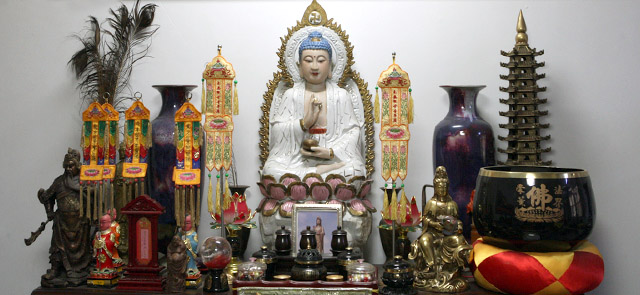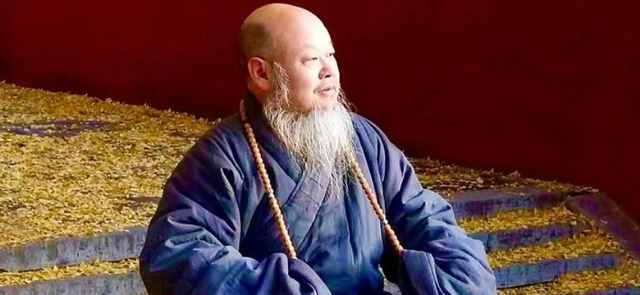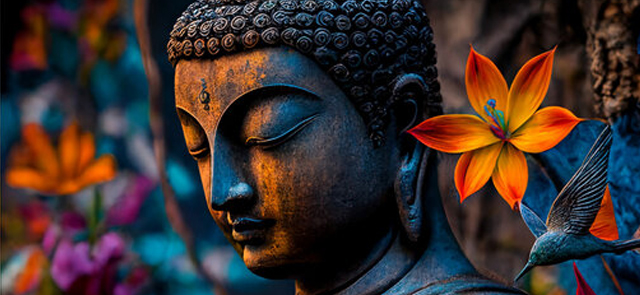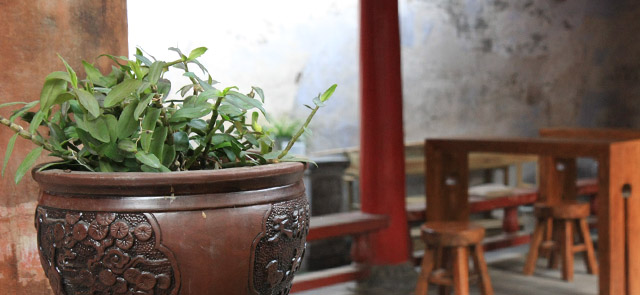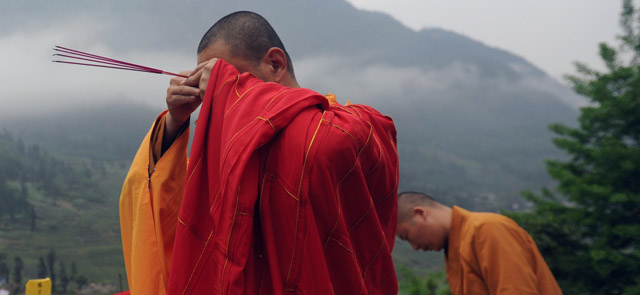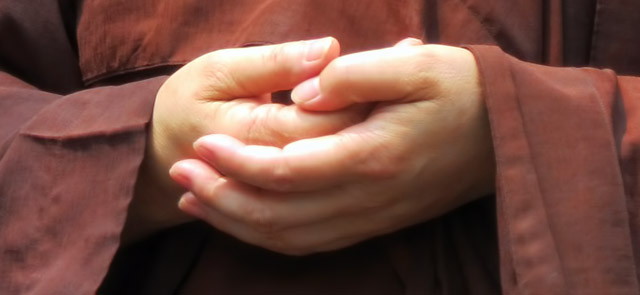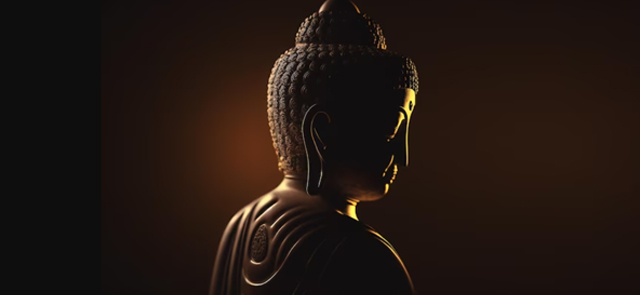The reason for setting up an altar is not for fame, for showing off wealth, or to increase pride, but rather it is to reduce one's mental afflictions and to seek the ability to help all sentient beings.
Making Offerings
There are no limitations to what can be offered, and there are many levels of offerings. In general, one can offer any pleasing object, particularly objects pleasing to the five senses form, sound, smell, taste, and touch.
The making of offerings is an antidote to the pattern of attachment and greed.Basic offerings [Chin.: Fójù 佛珠] of candles, evergreens and incense; called The three essential articles for worship are placed in front of the altar [Chin.: Fójiào jìtán 佛教祭坛] where the Buddha statue is enshrined. One or two candles are generally offered to provide light. One or two vases of evergreen are arranged on the altar in lieu of flowers that in Indian tradition were scattered over the Buddha as an offering.
Master Shi Yan Zhuo | 1965 - ?]
Three sticks of incense are burned as an offering of fragrance. In addition, a cup of fresh water is generally placed in front of the Buddha in the morning, water being highly regarded in the hot country of India where Buddhism started. It also has become traditional to offer fruit or other food, in the spirit of the Buddha's disciples who offered him food.Much symbolism has been attached to these offerings over the centuries, but none of it constitutes the essence of faith. Today many view these offerings as creating an environment conducive to chanting and as symbolizing basic human needs: water and food sustain life, candles and incense engages our senses, while evergreen reminds us of the eternity of life.
As a temple's main Dharma Hall, the Buddha-altar is the temple in the middle of the home.
Master Shi Yan Zhuo [Chin.: shìyánzhuó | 1965 - ?]
Greens, Candles, Incense and Other Offerings
The traditional basic material offerings to the Buddha are evergreens, candles and incense. This triad has symbolic significance: the evergreens, candles and incense represent the three truths, the three properties and the three inherent potentials of the Buddha nature. Hence the tradition is that "The evergreens" that represents the property of action is made into incense, and this is lit with the flame of wisdom that represents the property of wisdom; together, they fill the realm of the Law. Thus it is called the offering of the Buddha's Three Properties of the Law, wisdom, and action."
Evergreens symbolize the "property-of-action", the Buddha's enlightened physical property or his compassionate action and the potential to form a correct relationship with the environment that allows us to manifest our Buddha nature. The evergreens are used to adorn the space before the Buddha, which is eternal and supreme. Therefore, they should be something symbolic of permanence and purity.
The "Illicium Verum" - Bajiaohuixiang tree remains the same throughout the year, regardless of season: it's an evergreen that always displays vitality. But unlike pines, cedars, and other evergreen trees and bushes, it's also an aromatic tree whose wood has a distinctive fragrance. This fragrance is thought to ward off evil and to have the power to purify. That makes shikimi the ideal offering to the Buddha.
However, flowers are also an acceptable offering. The flowers offered to a Buddha are also symbolic of the faith of those worshipping the Buddha, as expressed by the old saying, "the reality of the votary is manifest [in the flowers he offers]." So the deep evergreen colour of the shikimi's leaves also represents the unchanging steadfastness of believers' faith.
Candles [Chin.: làzhú ??] stand for the truth of non-substantiality or the latent potential of life. They also represent the property of wisdom or the Buddha's enlightened spiritual property and they symbolize the potential wisdom to become aware of our innate Buddha nature. Burning candles thus also signifies incinerating earthly desires and the sparking of the flame of wisdom in the Buddha nature.
The last of the triad is the incense [Chin.: xi?nghu? ??]. It represents the truth of the Middle Way, the essential property of the Buddha's life or the property of the Law, and the potential of our innate Buddha nature. Three sticks of incense are burned in a flat position so as to help engender a feeling of serenity before the Buddha. These three sticks represent the Buddhist Triad []Chin.: Fójiào sān hé huì 佛教三合会], Fo, Fa, Seng [Chin.:Fú fǎ sēng 佛法僧]. The incense burner is placed in the centre of the altar, and incense is burned from left to right. Incense serves to create a fragrant atmosphere and is burned in front of the Buddha during morning and evening praying.
"The practice of offering is a very important preparation since it creates a vast amount of merit and makes our mind very strong."This indicates that all things encompass the True Aspect of the Middle Way, as well as elucidates that the fragrance of incense includes the virtues of the Buddha of the Law Body of the Middle Way. Thus burning incense, while spreading fragrance throughout the room, also signifies, through the fragrance's spreading throughout the environs, the universality of the realm of the Law of the Buddha's property of the Law.
Grand Master Shi Yong Po.
Symbolically, the light (candle) signifies the light of the Buddha's wisdom, or his "property of wisdom"; the greens, the Buddha's conduct, or his "property of action"; and the incense, the life of the Buddha which is the fusion of the realm of the Original Infinite Law and the inherent wisdom of the Buddha. Overall, this expresses the Buddha, whose property of the Law inherently encompasses the wisdom of his property of wisdom, and the conduct resulting from his property of action; in other words, the flowers (greens), incense, and light represent the Three Inherent Potentials of Buddha Nature.
Water, Fruit and Bell
In addition to the triad of basic offerings (evergreens, candles and incense), there is the water cup, offering dish, and bell. Fresh water is placed in a cup before the Buddha prior to morning praying and is removed just before evening praying. After being offered, the water may be put into another cup and then consumed.
Food, such as fruit, is another offering to the Buddha. Cooked food is sometimes offered on special occasions, such as New Year's Day. When offering food, we ring the bell three times, place our palms together and chant Namo Amituofo three times as a gesture of deep gratitude and appreciation. The fruit may be consumed after it has been offered to the Buddha.
The ringing of the bell during praying or bowing serves to offer a pleasing sound to the Buddha. It should therefore not be sounded jarringly, but in a way that is pleasing to the ear.
Expression of Sincerity, Respect and Appreciation
To clean the altar and offer fresh water each day, to make offerings of greens and fruit, and to light candles and burn incense while praying and chanting are all forms of service to the Buddha. These actions serve to honour the Buddha and dignify the place where it is enshrined. Moreover, our sincerity, respect and appreciation toward the Buddha will be reflected in the form of benefit.
Having a shrine and making offerings to it is a way of focusing our mind in a powerful and positive way. Day by day, week by week, month by month, year by year, if we do prayers and practices, that place will become a sacred place.Removing the Offerings
Grand Master Shi Yong Po
At the end of the day, before sunset , empty the bowl, dry it with a clean cloth and stack it upside down. Don't leave any empty bowl right side up on the altar. The water is not simply thrown away but offered to the plants in your house or in the garden. Food and flowers should also be put in a clean place outside where birds and animals can eat them. Bowls of fruit can be left on the altar for a few days and can then be eaten when they come down - there is no need to put them outside.
To the Buddha, the Dharma and the Supreme Community,
I go for refuge until Awakening,
May I achieve the state of a Buddha for the sake of all living beings.
